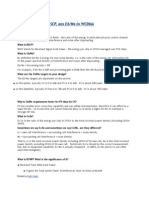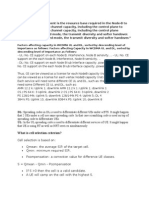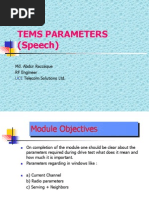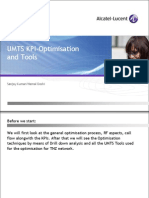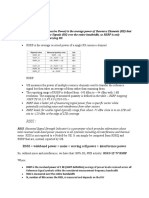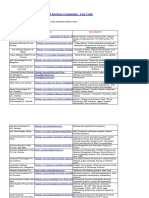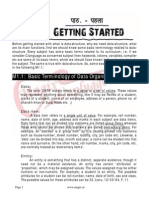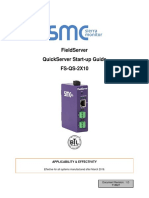RF Planning and Drive Test
RF Planning and Drive Test
Uploaded by
agmebaldCopyright:
Available Formats
RF Planning and Drive Test
RF Planning and Drive Test
Uploaded by
agmebaldOriginal Description:
Copyright
Available Formats
Share this document
Did you find this document useful?
Is this content inappropriate?
Copyright:
Available Formats
RF Planning and Drive Test
RF Planning and Drive Test
Uploaded by
agmebaldCopyright:
Available Formats
DRIVE TEST OF 2G,3G,4G AND 5G
1.1.1 GSM (2G) DRIVE TEST PARAMETERS
● Rx level : Indicates received signal strength in dbm
● Rx Quality: Indicates Quality of voice, which is measured on the basis of
BER (Range 0-7 where value 0 denotes minimum BER.
● C/I: The carrier-over-interference ratio is the ratio between the signal
strength of the current serving cell and the signal strength of undesired
(interfering) signal components (Unit is dB)
● FER: Frame Erasure Rate it represents the percentage of frames being
dropped due to high number of bit errors in the frame. It is indication of
voice quality in network.
Figure 1: Screenshot of a Drive test window
1.2 BASIC WCDMA DRIVE TEST PARAMETERS
1.2.1 CPICH EC/NO:
Chip Energy by Noise- Common Pilot channel Ec/No (CPICH Ec/No) is the ratio of
the energy of the chip and the combined power of all the signals including the specific
pilot channel. It also shows the level of Noise disrupting the specific CPICH.
Ranges for Ec/No:
● 0 to -7 Good
● to -10 Acceptable
● 10 to -36 Bad
1.2.2 CPICH RSCP:
Received signal Code Power is the level of the signal received by the U.E. or in
simple RSCP is the total power of the entire cell or a specific Common Pilot Channel
received by the user Equipment.
Ranges of RSCP:
● 30 to -75 Good
● 75 to -85 Acceptable
● 85 to -140 Bad
1.2.3 TX POWER:
Tx Power is the transmitting power of the mobile station. Its value can vary from
50 to -50. The minimum the Tx Power of the mobile station the better it is for call
quality. Tx Power is the power of a mobile station measured in the dedicated mode. If
you are in a low coverage area the mobile will increase its Tx power to avoid your call
from being dropped.
1.2.4 RSSI:
Received Signal Strength Indicator is the total power of the entire common pilot
channel received by the Mobile station Including Neighbors interference and noise as
well as neighbors and itself also.
RSSI= RSCP + Ec/No
RSSI Ranges:
● 0 to -75 Good
● -75 to -85 Acceptable
● -85 to -140 Bad
1.2.5 SIR:
Signal to Interference ratio is the ratio of energy in the DPCC (Dedicated Physical
control channel) to that of the interference and noise received by the User Equipment.
1.2.6 SQI:
It is the speech quality index which is a parameter to rate the voice quality on
that particular call. It ranges from 0 to 30. While 30 being the Best Value. Adaptive Multi
Rate (AMR) is also used to enhance the speech or the voice quality of the specific call.
WCDMA use AMR source Coding. AMR vary with different Ranges Highest AMR
Value is 12.20 and lowest AMR value is 4.75.
1.2.7 RRC STATE:
It tells the current state and channel as in idle or dedicated.
1.2.8 CELL NAME:
Specific Name of the Node B allotted by the Operator according to its location
and Serial value.
1.2.9 SCRAMBLING CODES:
Scrambling Codes are usually used to identify different cells of a node B.
They are of two types.
1- Secondary Scrambling Code
2- Primary Scrambling Code
Secondary Scrambling Code are used in Beam forming cases.
Primary Scrambling codes (0 to 511) are actually the Scrambling codes usually
used to identify different sectors. They totally lies from 0 to 8191. Moreover 512 PSC are
divided into a group of 64.Each contains 8PSC.
Total Down link Scrambling Codes 16*8=512.
1.2.10 AS (ACTIVE SET):
Set of scrambling codes on which the user equipment is currently latched on.
There can be at least maximum three scrambling's codes in an Active Set.
1.2.11 MN (MONITORED NEIGHBOR):
Neighbor cell that is detected by user equipment as a neighbor.
1.2.12 DN (DETECTED NEIGHBOR):
Detected Neighbor are cells detected by UE, which are neither in the Active set
nor in the Monitored set. (Missing Neighbor Definitions). Hence the U.E does not
handover onto these cells. It can be because of Overshooting, incomplete neighbor list
or in case of a new site. It is very important to optimize a network and have no DN’s as
they are one of the major reasons of call drops in 3G.
1.2.13 WCDMA (3G) DRIVE TEST PARAMETERS
RSCP (Received Signal Code Power)
The received power on one code measured on the Primary CPICH. Unit is dbm. It
shows the signal strength of a cell. It Indicates Coverage.
RSSI (Received Signal Strength Indicator)
It is the wide-band received power within the relevant channel bandwidth. It is a
parameter in dbm that describes the total signal strength of a UTRA carrier frequency
i.e. signal strength of all cells of same frequency at a certain location.
Ec/No
It is a parameter in dB that describes the received energy per chip divided by the
power density in the band. Measurement shall be performed on the Primary CPICH.It
shows signal quality. Value of Ec/No>-15dB is considered good, between -15db and -18
dB is poor and less than -18dB is very poor.
Main reasons of poor Ec/Io are poor RSCP, missing neighbours, overshooting,
pilot pollution etc.
1.2.14 ACTIVE, MONITORED AND DETECTED SETS
Cells that the UE is monitoring are grouped in the UE into three mutually
exclusive categories:
● Active Set: Active Set is defined as the set of cells the UE is simultaneously
connected to (i.e., the UTRA cells currently assigning a downlink DPCH to
the UE constitute the active set).
● Monitored Set: Cells, which are not included in the active set, but are
included in the CELL_INFO_LIST belong to the Monitored Set i.e. shows
probable candidate sectors for handovers. If one of the active cells
becomes weak, it is replaced by a candidate cell having highest signal
strength from monitored set.
● Detected Set: Cells detected by the UE, which are neither in the
CELL_INFO_LIST nor in the active set belong to the Detected Set. All the
missing neighbors appear in detected set. These must not have high
signal strengths otherwise they will degrade the aggregate Ec/No & lead
to call drops.
Pilot Pollution
When the number of strong cells exceeds the active set size, there is
“Pilot Pollution” in the area. Pilot pollution is the detection of many high power pilots as
compared to Best Serving Pilot that do not contribute to improve the signal strength. It
ultimately degrades the aggregate Ec/Io leading to call drop. All other strong signals
received when Active Set Size is full, act as interference which degrades the
performance of the system. Physical optimization should be done so that there should
not be many Pilots available at same spot with equally high signal strengths.
RADIO NETWORK OPTIMIZATION LTE USING DRIVE TEST
Once some hundreds of sites are on air, it becomes necessary to perform
optimization on the network in order to maximize benefits while minimizing capital and
operation costs for operators. This section, in fact, deals with all aspects of optimizing a
GSM network starting from standard operations and ending with specific trials, studies
and fine-tuning. Before the network is commercially launched, the radio network
optimization process starts and then continues during the life of the network.
Depending on the type of network management system, either in the BSC or in
the BTS, each cell reports thousands of statistics about all relevant behaviors (number of
attempts, failures, successes, during call, handover, setup, etc.). These statistics are
reported to the Network Management System (NMS) as counters. To facilitate
interpretation of the behavior, a set of key performance indicators (KPIs) is defined out
of formulas using pure counters. Each operator chooses its own KPIs and sets, according
to specific criteria, some objectives to be met in order to achieve a good end user
perception of the service offered and also in order to benchmark one network with
other operators.
Another aspect that is important in the optimization phase deals with drive tests.
In fact, while statistics give a general idea of the cell’s behavior at a certain period, field
measurements give a one instant scenario of one area’s behavior during a call. Different
tools can be used to perform drive tests. Each specific tool is able to standard reporting
at the signal level, quality and site information (cell identity, BCCH, mobile allocation list,
best neighbors, etc.).
Statistics and drive tests are the main methods used to monitor the network’s
performance. However, other specific methods can also be used. Tracing catches one
object’s behavior (TRX, cell, BTS or BSC) during a certain period and regarding a specific
event (SDCCH allocation, conversation phase of a voice call, etc.) or a set of successful
events (IMSI attach, paging, call setup, location update, etc.). Alarm monitoring,
transmission network auditing and network switching subsystem (NSS) performance
follow-up are also important in the sense that they give an idea of hardware problems or
parameter errors.
After deep analysis, actions are then taken to correct and improve performance.
All the above-described methods help the optimization engineers to identify the origin
of the problem from the office while applying several analysis methods. Another aspect
is, however, very important: field knowledge. Correct site re-engineering is the basis for
a good performing network. Frequency planning review is also a key step in the process.
Network planning optimization consists of various operations, all leading to the
improvement of KPIs. input data for starting optimization are KPI values in a certain
area. Depending on whether the area KPI is greater or less than the target,
troubleshooting on a cell basis starts and statistics can be extracted weekly, daily or
even on an hourly basis from the NMS. The Call Setup Success Rate (CSSR) and dropcall
rate (DCR) are the main KPIs relevant to operator losses.
1.3 DRIVE TESTING
1.3.1 WHAT IS DRIVE TEST
Drive Testing is a method of measuring and assessing the coverage, capacity and
Quality of Service (QoS) of a mobile radio network. Drive testing is principally applied in
both the planning and optimization stage of network development. Drive tests are the
most common measurement tool used by operators, to probe the quality status and
solve network problems.
1.3.2 DRIVE TESTING
The technique consists of using a motor vehicle containing mobile radio network
air interface measurement equipment that can detect and record a wide variety of the
physical and virtual parameters of mobile cellular service in a given geographical area.
It is conducted for checking the coverage criteria of the cell site with the RF drive
test tool.
The data collected by drive test tool in form of Log files are assessed to evaluate
the various RF parameters of the network.
1.3.3 DATA ACQUIRED FROM DRIVE TEST:
The dataset collected during drive testing field measurements can include
information such as
● Signal intensity
● Signal quality
● Interference
● Dropped calls
● Blocked calls
● Call statistics
● Service level statistics
● QoS information
● Handover information
● Neighbouring cell information
● GPS location co-ordinates
1.3.4 TYPES OF DRIVE TESTING
● Network Benchmarking
● Optimization & Troubleshooting
● Service Quality Monitoring
Network Benchmarking
Sophisticated multi-channel tools are used to measure several network
technologies and service types simultaneously to very high accuracy and collect accurate
competitive data on the true level of their own and their competitors technical
performance and quality levels
Optimization & Troubleshooting
Optimization and troubleshooting information is more typically used to aid in
finding specific problems during the rollout phases of new networks or to observe
specific problems reported by consumers during the operational phase of the network
lifecycle.
Service Quality Monitoring
Service quality monitoring typically involves making test calls across the network
to a fixed test unit to assess the relative quality of various services using Mean opinion
score (MOS).Service quality monitoring is typically carried out in an automated fashion.
The results produced by drive testing for each of these purposes is different.
1.3.5 DRIVE TEST EQUIPMENT
Following Resources/Equipments are required for drive test
● A Laptop
● Drive Test software with Dongle/License Key
● GPS (Global Positioning system) to provide location information
● One or Multiple Handsets Compatible with the Drive Test Software
● Scanner (Optional)
● Database of Existing Network (Cell site database)
● A Suitable Vehicle
1.3.6 CONNECTIVITY OF DRIVE TEST TOOL
As shown in figure, all the equipments (GPS, Mobile Handsets, Dongle) are
connected to Laptop via USB ports. Normally antenna type GPS (with magnetic base to
stick on top of vehicle) is used with drive test tool.
Figure 2: Connectivity of Drive Test Tool
1.3.7 DRIVE TEST TOOLS
Data Collection Tools
● TEMS Investigation
● Nemo Outdoor
● JDSU E6474A
● Accuver XCAL
Post-processing tools
● Actix Analyzer/Spotlight
● Accuver XCAP
● TEMS Discovery LTE
1.3.8 LTE DRIVE TEST PARAMETERS
● RSRP: Reference Signal Received Power.
● RSRQ: Reference Signal Received Quality.
● RSSI: Received Signal Strength Indicator.
● SINR : Signal to Interference Noise Ratio
● CQI: Channel Quality Index.
● PCI: Physical Cell Identity.
● BLER: Block Error Ratio.
● DL Throughput: Down Link Throughput.
● UL Throughput : Up Link Throughput
This is the common key performance parameters for LTE drive test parameter we
have to work out for LTE drive test task.
RSRP:
It indicates coverage. RSRP is the average power received from a single
Reference signal, and its typical range is around -44dbm (good) to -140dbm (bad).
RSRQ:
RSRQ – Indicates quality of the received signal and its range is typically -19.5dB
(bad) to -3dB (good).
RSSI:
RSSI (Received Signal Strength Indicator) is a parameter which provides
information about total received wide-band power (measure in all symbols) including all
interference and thermal noise.
RSSI = wideband power = noise + serving cell power + interference power
RSSI is related to the other parameters through the following formula:
RSRQ=N*(RSRP/RSSI)
Where N is the number of Resource Blocks of the E-UTRA carrier RSSI
measurement bandwidth.
SINR:
SINR is the reference value used in the system simulation and can be defined:
● Wide band SINR
● SINR for a specific sub-carriers (or for a specific resource elements)
All measured over the same bandwidth!
RSSP vs RSRQ vs RSSI vs SINR
Below is a chart that shows what values are considered good and bad for the LTE
signal strength values:
Table 1. LTE signal strength values
CQI:
The Channel Quality Indicator (CQI) contains information sent from a UE to the
eNode-B to indicate a suitable downlink transmission data rate, i.e., a Modulation and
Coding Scheme (MCS) value. CQI is a 4-bit integer and is based on the observed signal-
to-interference-plus-noise ratio (SINR) at the UE. The CQI estimation process takes into
account the UE capability such as the number of antennas and the type of receiver used
for detection. This is important since for the same SINR value the MCS level that can be
supported by a UE depends on these various UE capabilities, which needs to be taken
into account in order for the eNode-B to select an optimum MCS level for the
transmission. The CQI reported values are used by the eNode-B for downlink scheduling
and link adaptation, which are important features of LTE.
In LTE, there are 15 different CQI values ranging from 1 to 15 and mapping
between CQI and modulation scheme, transport block size is defined as follows :
Table 2. 15 different CQI values
Table 3. 15 different CQI values
BLER:
A Block Error Ratio is defined as the ratio of the number of erroneous blocks
received to the total number of blocks sent. An erroneous block is defined as a Transport
Block, the cyclic redundancy check (CRC) of which is wrong.
5G Drive Test Parameter:-
SS-RSRP:-synchronization Signal - Reference Signal Received Power' (SS-RSRP)
measurements are used for cell selection, cell reselection, power control calculations,
mobility procedures and beam management. Measurements can be generated and
reported at both Layer 1 and Layer 3. SS-RSRP represents the average power received
from a single Resource Element allocated lo the Secondary Synchronisation Signal
SS-RSRQ
'Synchronisation Signal - Reference Signal Received Quality' (SS-RSRQ) measurements
can be used for cell selection, cell reselection and mobility procedures. In contrast to
RSRP measurements, RSRQ measurements are not used when reporting Channel State
The RSRP and RSSI are both measured across the same set of Resource Blocks.
SS_SINR:- 'Synchronisation Signal - Signal to Interference and Noise Ratio' l[SS-SINR)
measurements can be used for connected mode mobility procedures. The SS-SINR
represents the ratio of the wanted signal power to the interference plus noise power.
The wanted signal power and the interference plus noise power arc measured from
Resource Elements used by the Secondary Synchronisation Signal.
CSI-RSRP:- 'CSI Reference Signal Received Power' (CSI-RSRP) mcasuremen1ts arc used
for connected mode mobility, power control calculations, and beam management.
Measurements can be generated and reported at both layer I and layer 3. For example, a
UE can provide CSI-RSRP measurements at Layer I when sending Channel State
information (CSI) to the Base Station. Alternatively, a UE can provide
CSI-RSRP measurements at Layer 3 when sending an RRC: Measurement Report.
CSI-RSRQ:-
CSI Reference Signal Received Quality' (CSJ-RSRQ) measurements can be used for
mobility procedures. In contrast to RSRP measurements, RSRQ measurements are not
used when reporting Channel State information (CSI).
CSI-SINR:-
'CSl Reference Signal Signal to interference and Noise Ratio' (CSI-SINR) measurements
can be used for connected mode mobility procedures. The CSI-SINR represents the ratio
of the wanted signal power to the interference plus noise power. 130th the wanted
signal power and the interference plus noise power arc measured from Resource
Elements used by the CS! Reference Signal.
You might also like
- Answer: (C)Document3 pagesAnswer: (C)amin minshaf100% (1)
- Mobile Network Optimization: A Guide for 2G and 3G Mobile Network OptimizationFrom EverandMobile Network Optimization: A Guide for 2G and 3G Mobile Network OptimizationRating: 3.5 out of 5 stars3.5/5 (3)
- Automated Broad and Narrow Band Impedance Matching for RF and Microwave CircuitsFrom EverandAutomated Broad and Narrow Band Impedance Matching for RF and Microwave CircuitsNo ratings yet
- Indoor Radio Planning: A Practical Guide for 2G, 3G and 4GFrom EverandIndoor Radio Planning: A Practical Guide for 2G, 3G and 4GRating: 5 out of 5 stars5/5 (1)
- A Guide to Electronic Maintenance and RepairsFrom EverandA Guide to Electronic Maintenance and RepairsRating: 4.5 out of 5 stars4.5/5 (7)
- Chapter 2 CADDocument13 pagesChapter 2 CADLavitSutcharitkulNo ratings yet
- 4G Drive Test ParametersDocument58 pages4G Drive Test ParametersAhmed Torki100% (4)
- Lte Drive Test ParametersDocument57 pagesLte Drive Test ParametersdocteurgynecoNo ratings yet
- Shams Touhid: 1 Electronics & Communication DepartmentDocument18 pagesShams Touhid: 1 Electronics & Communication DepartmentshamstouhidNo ratings yet
- Drive Test Analysis 1Document16 pagesDrive Test Analysis 1Shashank Prajapati100% (1)
- Mohd. Abid KhanDocument18 pagesMohd. Abid KhanshamstouhidNo ratings yet
- 3G QuestionDocument7 pages3G QuestionOmran QureshiNo ratings yet
- 3GDocument10 pages3GAkhtar KhanNo ratings yet
- SIR, Ec/Io, RTWP, RSCP, Ans Eb/No in WCDMA: Ruth SinghDocument11 pagesSIR, Ec/Io, RTWP, RSCP, Ans Eb/No in WCDMA: Ruth SinghAnkur MisraNo ratings yet
- KPI Introduction: Admin No CommentsDocument4 pagesKPI Introduction: Admin No CommentsMustafa AliNo ratings yet
- CE (Channel Element) in WCDMADocument19 pagesCE (Channel Element) in WCDMAKausik RaychaudhuriNo ratings yet
- UMTS Interview Questions and AnswerDocument16 pagesUMTS Interview Questions and AnswerSuhelSiddiquiNo ratings yet
- WCDMA Drive Test Parameters Details: CPICH OptimizationDocument4 pagesWCDMA Drive Test Parameters Details: CPICH OptimizationionwiratamaNo ratings yet
- GSM Network Planning: Charotar Institute of Technology, ChangaDocument34 pagesGSM Network Planning: Charotar Institute of Technology, ChangaPawan PatidarNo ratings yet
- 2g ParameterDocument176 pages2g ParameterNitin PandeyNo ratings yet
- Drive Test Using Tems Investigation16Document30 pagesDrive Test Using Tems Investigation16Khusni Eka WardanaNo ratings yet
- Tems Parameters (Selim)Document14 pagesTems Parameters (Selim)khoandNo ratings yet
- Wireless Tech TermsDocument25 pagesWireless Tech TermsSreetej GondiNo ratings yet
- InterviewDocument24 pagesInterviewCatherine RyanNo ratings yet
- Tems Parameters (Speech) : Gaurav Shivhare, Dinesh Rathor RF EngineerDocument15 pagesTems Parameters (Speech) : Gaurav Shivhare, Dinesh Rathor RF EngineerMD SahidNo ratings yet
- Tems ParametersDocument14 pagesTems ParametersMuhammad IkhsanNo ratings yet
- Drive Test With TEMSDocument33 pagesDrive Test With TEMSMuhammad Bilal JunaidNo ratings yet
- Tems Parameters: Very Useful For BeginnersDocument14 pagesTems Parameters: Very Useful For Beginnerssophist1No ratings yet
- Tems Parameters (Selim)Document14 pagesTems Parameters (Selim)atukmedyanNo ratings yet
- RSRPDocument4 pagesRSRPMuhammad IqbalNo ratings yet
- 01B - Drive Test AnalysisDocument58 pages01B - Drive Test AnalysisFulanNo ratings yet
- Drive Test With TemsDocument34 pagesDrive Test With TemsMostafa Abd El AzizNo ratings yet
- Drive Test With TEMSDocument34 pagesDrive Test With TEMSSiavash SalarzehiNo ratings yet
- Downlink Throughput TroubleshootingDocument21 pagesDownlink Throughput TroubleshootingRajeev Sharma100% (2)
- Tems Parameters (Speech) : Md. Abdur Razzaque RF Engineer Telecom Solutions LTDDocument14 pagesTems Parameters (Speech) : Md. Abdur Razzaque RF Engineer Telecom Solutions LTDMohammad UmerNo ratings yet
- Tems Para) : Adacellworks PresentationDocument15 pagesTems Para) : Adacellworks PresentationardhendumohantyNo ratings yet
- Drive Test With TEMSDocument34 pagesDrive Test With TEMSkpgs12No ratings yet
- 2g.... Tems ParametersDocument15 pages2g.... Tems ParametersRamKumarLohkana100% (1)
- Tems ParameterDocument15 pagesTems ParameterchlaxminarayanaNo ratings yet
- Tems Parameters (Speech)Document15 pagesTems Parameters (Speech)Charles WeberNo ratings yet
- Lte Optimization StepDocument5 pagesLte Optimization StepGaurav MishraNo ratings yet
- For New Drive TesterDocument27 pagesFor New Drive TesterMohamed El-SayedNo ratings yet
- On Which Physical Channel Are The Sibs (System Information Blocks) Transmitted?Document14 pagesOn Which Physical Channel Are The Sibs (System Information Blocks) Transmitted?BilalAhmadNo ratings yet
- Tems ParametersDocument15 pagesTems Parametersganeshtomar880% (5)
- OPTIMIZATIONDocument33 pagesOPTIMIZATIONIslam BarakatNo ratings yet
- 3G QuestionsDocument11 pages3G QuestionsHumayun KabirNo ratings yet
- GSM Planning & Architecture: Mid Term ReportDocument15 pagesGSM Planning & Architecture: Mid Term ReportRamit DwivediNo ratings yet
- LTE Drive Test Parameters PDFDocument11 pagesLTE Drive Test Parameters PDFNguyen Thanh VuNo ratings yet
- UMTS KPI-Optimisation & ToolsDocument41 pagesUMTS KPI-Optimisation & ToolsSukhdeep SinghNo ratings yet
- VivaDocument31 pagesVivaRahul KumarNo ratings yet
- Questions With Answers Lte UpdatedDocument51 pagesQuestions With Answers Lte UpdatedNuman KhanNo ratings yet
- High-Performance D/A-Converters: Application to Digital TransceiversFrom EverandHigh-Performance D/A-Converters: Application to Digital TransceiversNo ratings yet
- Analog Dialogue Volume 46, Number 1: Analog Dialogue, #5From EverandAnalog Dialogue Volume 46, Number 1: Analog Dialogue, #5Rating: 5 out of 5 stars5/5 (1)
- BICSI RCDD Registered Communications Distribution Designer Exam Prep And Dumps RCDD-001 Exam Guidebook Updated QuestionsFrom EverandBICSI RCDD Registered Communications Distribution Designer Exam Prep And Dumps RCDD-001 Exam Guidebook Updated QuestionsNo ratings yet
- Amateur Radio Electronics on Your MobileFrom EverandAmateur Radio Electronics on Your MobileRating: 5 out of 5 stars5/5 (1)
- List of Major Software Companies in IndiaDocument58 pagesList of Major Software Companies in Indiatester7288No ratings yet
- Fawn Write-Up: Definition On WikipediaDocument12 pagesFawn Write-Up: Definition On WikipediarikiNo ratings yet
- Computer Netork Lab ManualDocument46 pagesComputer Netork Lab Manualpandita9673No ratings yet
- The Lekha'S Waevguru Is An Ideal Tool For Realizing Networks Starting From 2G To 4G and Extension To 5G Concepts and Other Radio ApplicationsDocument3 pagesThe Lekha'S Waevguru Is An Ideal Tool For Realizing Networks Starting From 2G To 4G and Extension To 5G Concepts and Other Radio ApplicationsG S NaveenNo ratings yet
- Chapter 3Document37 pagesChapter 3Phú Quốc PhạmNo ratings yet
- Ad360 Quick Start GuideDocument25 pagesAd360 Quick Start GuidePrimeNo ratings yet
- LSI 9600 系列 PCIE4.0 RAID+eHBA 2022 3月Document4 pagesLSI 9600 系列 PCIE4.0 RAID+eHBA 2022 3月lekoqiu85No ratings yet
- Brochure and Schedule AAIPIVSEE - 2021Document4 pagesBrochure and Schedule AAIPIVSEE - 2021knighthood4allNo ratings yet
- RH066x EdX Lab Instructions-RHEL8Document13 pagesRH066x EdX Lab Instructions-RHEL8Celso Ioshitsugu OhphataNo ratings yet
- Finite State Machines: Ref:, Rosen BookDocument22 pagesFinite State Machines: Ref:, Rosen BookSomaiah SulaimanNo ratings yet
- Pseudo CodeDocument15 pagesPseudo Codegoyiyew212No ratings yet
- M1.1: Basic Terminology of Data Organization:: WWW - Magix.inDocument0 pagesM1.1: Basic Terminology of Data Organization:: WWW - Magix.inShweta SharmaNo ratings yet
- cs610 Quiz File by Vu Topper RMDocument29 pagescs610 Quiz File by Vu Topper RMMuhammad HaseebNo ratings yet
- Ex150-Cx2 (Ce-Ltd)Document7 pagesEx150-Cx2 (Ce-Ltd)darsh241193No ratings yet
- Fieldserver Quickserver Start-Up Guide Fs-Qs-2X10: Applicability & EffectivityDocument34 pagesFieldserver Quickserver Start-Up Guide Fs-Qs-2X10: Applicability & EffectivityNicol PérezNo ratings yet
- Ai For Enterprise Solution Overview Bright Cluster Manager 2304534Document2 pagesAi For Enterprise Solution Overview Bright Cluster Manager 2304534Num NumtrexNo ratings yet
- Fluent WaitDocument2 pagesFluent WaitPassion 4 OracleNo ratings yet
- Lect01 - Introduction To Web ServicesDocument15 pagesLect01 - Introduction To Web ServicesMohammed SaeidNo ratings yet
- Application Lifecycle MGT - Final ExamDocument20 pagesApplication Lifecycle MGT - Final ExamJaniceRemateNobleNo ratings yet
- 9 - ICT Skills NotesDocument26 pages9 - ICT Skills NotesriyaroyrulesNo ratings yet
- Andrew Sack ResumeDocument1 pageAndrew Sack ResumeAndrew SackNo ratings yet
- Instant Download Building Firewalls with OpenBSD and PF 2nd Edition Jacek Artymiak PDF All ChaptersDocument71 pagesInstant Download Building Firewalls with OpenBSD and PF 2nd Edition Jacek Artymiak PDF All Chapterszurcngengo100% (5)
- Lecture Notes Annex Unit 1 KCAA01Document106 pagesLecture Notes Annex Unit 1 KCAA01chaudhary03082000No ratings yet
- Software Engineering-week1-1-IntroductionDocument20 pagesSoftware Engineering-week1-1-Introductionbhaveeka1503No ratings yet
- Firefly-RK3399 V10 SCH (2017-2-8)Document30 pagesFirefly-RK3399 V10 SCH (2017-2-8)Satvik HardatNo ratings yet
- Intellimon InsertDocument2 pagesIntellimon Insertrahulasdfsharma1986No ratings yet
- CLOUD COMPUTING Class NoteDocument26 pagesCLOUD COMPUTING Class NoteUnknown FactsNo ratings yet
- Xii CSDocument2 pagesXii CSkillerbeam213No ratings yet













